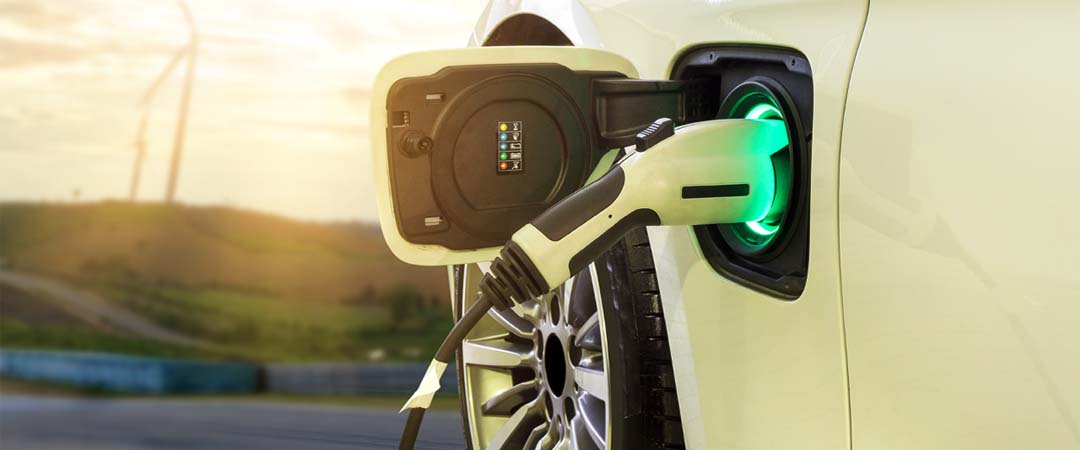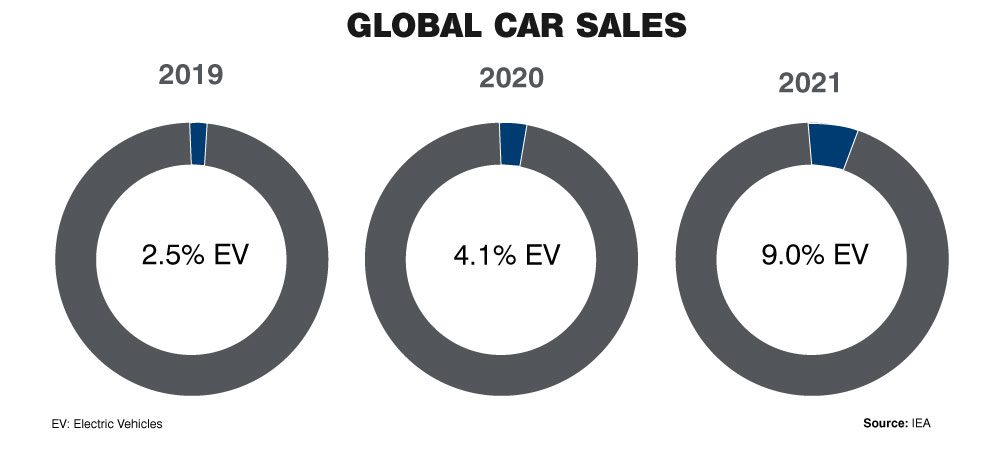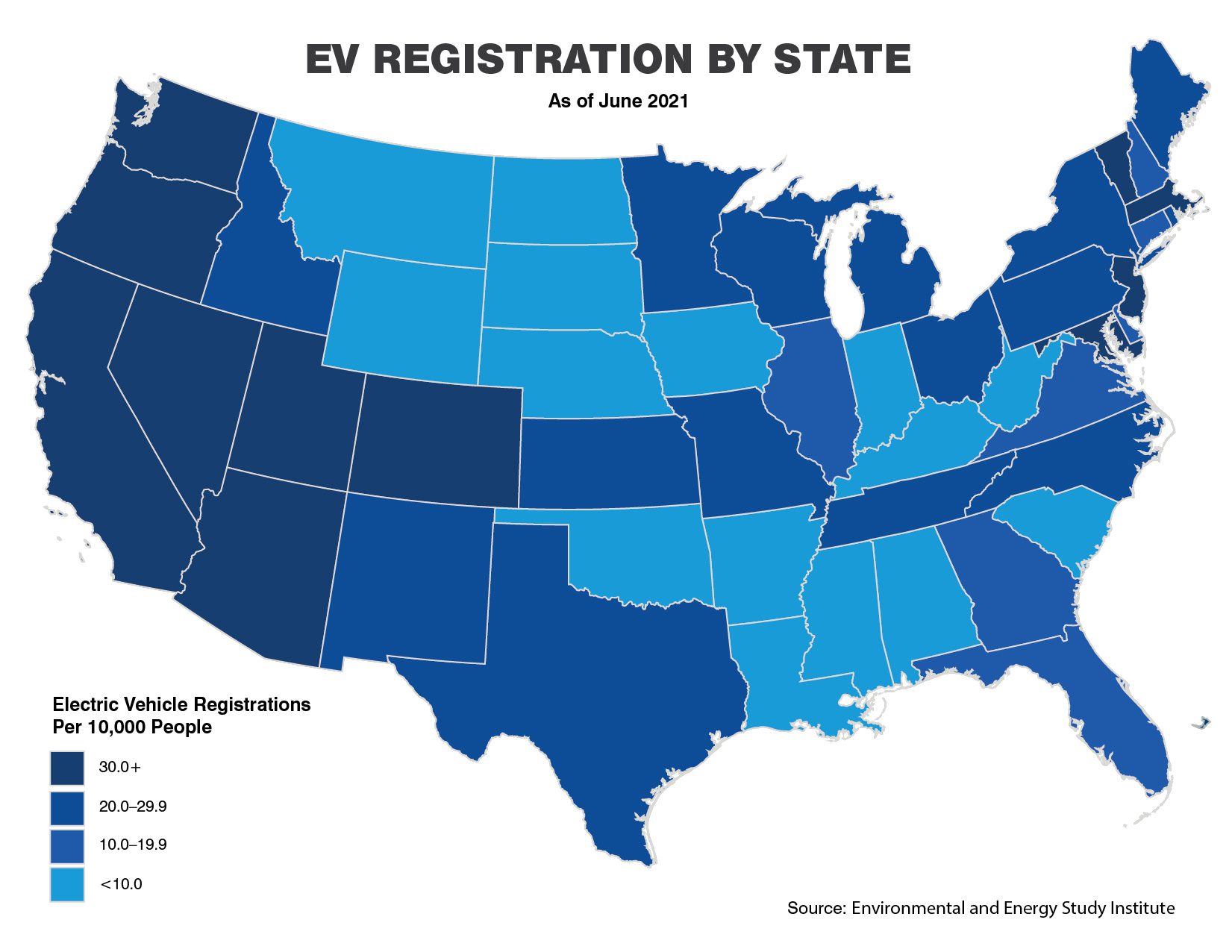
Electric vehicles have taken the world by storm in recent years. Growing electric vehicle (EV) sales, new administrative goals and ambitious auto manufacturing targets are evidence that EVs are unlikely to be a passing fad.
If current trends continue, the rate of EV adoption in the U.S. will increase greatly over the next decade. At the same time, however, widespread EV adoption faces many roadblocks, and many questions remain unanswered.
As you look into 2022 and the next 10 years, here’s what you and your business should know about the exponential increase of EV sales.
Recent electric vehicle adoption trends
EV sale trends have been quickly increasing around the globe. In the first half of 2021, approximately 5.6 million EVs were sold internationally — equivalent to about $244 billion in sales — which is a huge jump from 3.1 million sales in 2020 and 2.1 million in 2019. Additionally, there were more than 500 zero-emission vehicles available as of 2021, or 37% more models than those manufactured in 2019.
In 2021 alone, 9% of global car sales were electric vehicles, which is a significant increase from 2019’s sales of less than 3%. As EV sales climb, internal combustion engine (ICE) vehicle sales will slowly decrease — as seen over the last couple years.

While this is still a small fraction of total vehicles on the road, the EV growth rate will only continue to increase — especially in the United States, considering President Biden’s goal to heavily reduce the emission of greenhouse gases during his time in office.
Executive order from the Biden administration
In fall 2021, President Biden announced an executive order initiating next steps toward reducing the emission of greenhouse gases. This order aims to have 50% of all new vehicles sold in 2030 electric.
While there is an executive order in place to phase out gasoline-powered vehicles, it is not a legally binding order but rather a flexible, ambitious goal for our nation — especially American car manufacturers. In fact, a handful of automakers — including GM, Ford and Volvo — have already pledged to make only zero-emission sales by the year 2040.
Prior to the Biden administration announcing the executive order, EV sales were beginning to skyrocket, with 2021 showing an 83% increase in global EV sales over 2020 and a 168% increase over 2019. With EV adoption already on the move, the executive order and established pledges are likely to reinforce current trends.
Urban versus rural capabilities
Urban areas in the U.S. have been implementing EV charging stations for years to accommodate the growing EV numbers; however, rural communities are lacking in charging infrastructure, which is slowing the nationwide adoption rate for EVs. In rural areas, EV registration rates are less than 0.5%, largely due to the absence of accessible, EV charging infrastructure.

Currently, large metro areas (e.g., West Coast, East Coast) have an average of 65 fast-charging stations per 1,000 square miles, but the large number of rural areas with zero charging infrastructure brings the national average down to 18. That said, the Department of Energy has calculated that for an EV driver to be within a three-mile radius of fast-charging infrastructure, there must be at least 56 charging stations per 1,000 square miles. This discourages EV drivers from traveling in areas where charging infrastructure density is limited or nonexistent.
With this in mind, the Biden administration plans to allocate $7.5 billion of the Infrastructure Investment to building 100,000–500,000 EV charging stations, primarily in rural areas where charging stations are few and far between, particularly in the Midwest and Southeast.
A coalition of 29 electric cooperatives in the Midwest has already created a regional EV charging network to encourage the drive of EVs in rural areas. “’Electric co-ops have brand awareness and a strong relationship with their members and communities,’ said Nate Boettcher, CEO of Pierce Pepin Cooperative Services in Ellsworth, Wisconsin. ‘We want to ensure when EV drivers leave their co-op service area they know other EV charging stations are available throughout the upper Midwest powered by electric co-ops.’” Additionally, more than 50 utilities have joined together to install EV, fast-charging infrastructure along busy U.S. highway corridors by the end of 2023, which further supports hesitant, perspective EV consumers.
Acknowledging uncertainty
It is important to note that EV adoption is at a critical point in the establishment of future EV trends.
“While passenger EV sales could be on the brink of entering the steepest exponential growth phase of the S-curve in many countries, progress made so far is not so advanced that it cannot be reversed. Strengthening policy, increasing investment and implementing equitable adoption incentives will be critical. Increasing EV sales alone will not be enough — reaching Paris Agreement targets will also require systemic changes to individual transport, such as rethinking in city planning and increasing public transport availability.” – World Resources Institute
In short, EV sales are on the rise, but whether this trend will become exponential or simply plateau is dependent on infrastructure, research and development investments, strong policy support at national and municipal levels and coordinated global action.
Prepping for the future
With a large population of automakers already making the pledge to transition to EV sales, data to back up benefits and solutions, and the movement to eliminate greenhouse gas emissions, EVs are likely to be a prominent asset to the automotive future by 2030.
Continue keeping a close eye on EV adoption trends and prepare for a massive, automotive transition.
Read more:
The State of the Electrician Shortage in 2022: New Data on the Impact of COVID-19